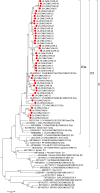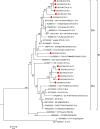Epidemiological and genetic characteristics of enteroviruses associated with hand, foot, and mouth disease in Jiaxing, China from 2019 to 2022
- PMID: 40281098
- PMCID: PMC12032032
- DOI: 10.1038/s41598-025-99251-x
Epidemiological and genetic characteristics of enteroviruses associated with hand, foot, and mouth disease in Jiaxing, China from 2019 to 2022
Abstract
Hand, foot, and mouth disease (HFMD) is mainly caused by enteroviruses (EVs) and represents an important public health problem in China. The aim of this study was to investigate the epidemiological and genetic characteristics of EVs associated with HFMD in Jiaxing City in 2019-2022. In total, 1807 clinical specimens collected from patients with HFMD were evaluated by real-time reverse transcription polymerase chain reaction, and 1553 EV-positive specimens were detected, including 1018 coxsackievirus A6 (CVA6), 301 coxsackievirus A16 (CVA16), 94 coxsackievirus A10 (CVA10), 7 enterovirus A71 (EV-A71), and 133 other EVs. A phylogenetic analysis revealed that the subgenogroups CVA6 D3a, CVA10 F, and CVA16 B1a B1b were predominant in Jiaxing. Compared with VP1 of the prototype strains of CVA6, CVA10, and CVA16, 34, 36, and 31 amino acid substitutions were detected, respectively. Children aged 1-5 years accounted for the majority of cases, and the infection rate was higher in males than in females. EV infection cases were clearly affected by the COVID-19 epidemic, with decreases in 2020 corresponding to the implementation of protective measures. These findings add to the global genetic resources for EVs and demonstrate the epidemiological characteristics and genetic features of HFMD in Jiaxing.
Keywords: Amino acid mutation; Enterovirus; Epidemiology; Genetic characteristics; Hand, foot, and mouth disease.
© 2025. The Author(s).
Conflict of interest statement
Declarations. Consent for publication: Both authors have read and agreed to the published version of the manuscript. Competing interests: The authors declare no competing interests.
Figures





Similar articles
-
Genetic Variation of Multiple Serotypes of Enteroviruses Associated with Hand, Foot and Mouth Disease in Southern China.Virol Sin. 2021 Feb;36(1):61-74. doi: 10.1007/s12250-020-00266-7. Epub 2020 Jul 28. Virol Sin. 2021. PMID: 32725479 Free PMC article.
-
Clinical features of hand, foot and mouth disease caused by Coxsackievirus A6 in Xi'an, China, 2013-2019: A multicenter observational study.Acta Trop. 2024 Sep;257:107310. doi: 10.1016/j.actatropica.2024.107310. Epub 2024 Jun 30. Acta Trop. 2024. PMID: 38955319
-
Genomic epidemiology of CVA10 in Guangdong, China, 2013-2021.Virol J. 2024 May 30;21(1):122. doi: 10.1186/s12985-024-02389-9. Virol J. 2024. PMID: 38816865 Free PMC article.
-
[Prevalence and Analyses of the Changing Etiology of Hand, Foot and Mouth Disease in China].Bing Du Xue Bao. 2015 Sep;31(5):554-9. Bing Du Xue Bao. 2015. PMID: 26738295 Review. Chinese.
-
Atypical hand-foot-mouth disease in Belém, Amazon region, northern Brazil, with detection of coxsackievirus A6.J Clin Virol. 2020 May;126:104307. doi: 10.1016/j.jcv.2020.104307. Epub 2020 Mar 6. J Clin Virol. 2020. PMID: 32302950 Review.
References
-
- Lizasoain, A., Mir, D., Martinez, N. & Colina, R. Coxsackievirus A10 causing hand-foot-and-mouth disease in Uruguay. Int. J. Infect. Dis.94, 1–3. 10.1016/j.ijid.2020.02.012 (2020). - PubMed
-
- Guo, W. P. et al. Fourteen types of co-circulating recombinant enterovirus were associated with hand, foot, and mouth disease in children from Wenzhou, China. J. Clin. Virol.70, 29–38. 10.1016/j.jcv.2015.06.093 (2015). - PubMed
MeSH terms
LinkOut - more resources
Full Text Sources

